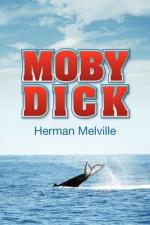Book II. (Octavo), chapter III. (Narwhale), that is, Nostril whale.— Another instance of a curiously named whale, so named I suppose from his peculiar horn being originally mistaken for a peaked nose. The creature is some sixteen feet in length, while its horn averages five feet, though some exceed ten, and even attain to fifteen feet. Strictly speaking, this horn is but a lengthened tusk, growing out from the jaw in a line a little depressed from the horizontal. But it is only found on the sinister side, which has an ill effect, giving its owner something analogous to the aspect of a clumsy left-handed man. What precise purpose this ivory horn or lance answers, it would be hard to say. It does not seem to be used like the blade of the sword-fish and bill-fish; though some sailors tell me that the Narwhale employs it for a rake in turning over the bottom of the sea for food. Charley Coffin said it was used for an ice-piercer; for the Narwhale, rising to the surface of the Polar Sea, and finding it sheeted with ice, thrusts his horn up, and so breaks through. But you cannot prove either of these surmises to be correct. My own opinion is, that however this one-sided horn may really be used by the Narwhale—however that may be—it would certainly be very convenient to him for a folder in reading pamphlets. The Narwhale I have heard called the Tusked whale, the Horned whale, and the Unicorn whale. He is certainly a curious example of the Unicornism to be found in almost every kingdom of animated nature. From certain cloistered old authors I have gathered that this same sea-unicorn’s horn was in ancient days regarded as the great antidote against poison, and as such, preparations of it brought immense prices. It was also distilled to a volatile salts for fainting ladies the same way that the horns of the male deer are manufactured into hartshorn. Originally it was in itself accounted an object of great curiosity. Black Letter tells me that Sir Martin Frobisher on his return from that voyage, when Queen Bess did gallantly wave her jewelled hand to him from a window of Greenwich Palace, as his bold ship sailed down the Thames; “when Sir Martin returned from that voyage,” saith Black Letter, “on bended knees he presented to her highness a prodigious long horn of the Narwhale, which for a long period after hung in the castle at Windsor.” An Irish author avers that the Earl of Leicester, on bended knees, did likewise present to her highness another horn, pertaining to a land beast of the unicorn nature.




